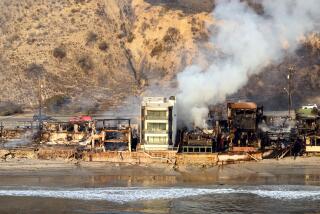Forget curb appeal — when it comes to fire-safe landscaping, think embers, meadows and ‘defensible space’
- Share via
With a “new abnormal” of bigger, badder wildfires, California homeowners are facing a paradigm shift in landscaping.
As much as you might crave an English cottage look, with vines framing your porch or stately groupings of evergreens and palms circling your home, when it comes to fire prevention, your first priority must be removing those plants and any other shaggy, combustible vegetation that serves as easy fuel for wind-borne embers.
“Research shows that 90% of the time, homes are ignited by embers, not a wall of flames,” said Jamie Roice-Gomes, manager of the University of Nevada Cooperative Extension’s Living With Fire Program.
The idea is to create an airy, open “defensible space” around your home and plant nothing that touches the structure or looms above it, said Robert Walton, assistant forester for the Los Angeles County Fire Department’s Fuel Modification Unit.
That means rethinking the traditional “foundation planting” of trees and shrubs up against a house, designed to blend structures with nature for maximum curb appeal.
Nowadays, we should plan our landscapes around how they look from inside our houses, not what people see from the street, Walton said.
Choose high-moisture, low-growing plants in your defensible space (think grassy meadow, with drifts of daffodils or succulents), with a few widely spaced “accents” of trees or shrubs.
Fire pros agree that it’s best to avoid combustible plants such as arborvitae and palms because they love to burn, but ultimately, Walton said, what you plant isn’t as important as where and how you plant, and how well you maintain it.
Here are some of Walton’s top tips for a fire-safe yard:
Start with nothing
Surround your house with a good 5 feet of hardscape, like concrete walkways or pea gravel paths, and make sure you keep them clear of “ember receptors” like dried leaves, needles or even stacks of wood. If you must have greenery within 5 feet of the house, plant drifts of flowering succulents, bulbs or other high-moisture, low-growing plants that don’t accumulate a lot of dead leaf litter.
Embrace the meadow
A wide swath of grass is a great firebreak, but it doesn’t have to be a traditional water-thirsty lawn, Walton said. Instead, consider some handsome, drought-tolerant grasses that discourage fire and — bonus! — don’t need to be mowed, such as buffalo grass (Buchloe dactyloides) or California meadow sedge (Carex pansa). Check out those and other options at grass ecologist John Greenlee’s website greenleeandassociates.com.
Succulents are your friends
When it comes to high-moisture plants, succulents are first in line, and the best choice for mass plantings near a structure, Walton said. Two popular flowering choices are Bulbine frutescens (check out the “Tiny Tangerine” variety, Walton says), a dainty, thornless succulent from South Africa with tall stalks of yellow and orange flowers, and Aloe striata, a.k.a. “Coral Aloe,” a broad-leaved, silver-green succulent that produces brilliant coral blooms.
Accent sparingly with shrubs and trees
Fire pros understand that deciduous trees are useful for shade, Walton said, but they should stand at least 10 feet from a structure and never overhang the roof. And don’t plant groupings of trees and shrubs, because those can create “fire ladders” that help flames spread from one plant to another.
Some popular flowering trees are Eastern Redbud (it has fewer seeds and less mess than the Western variety, Walton says), Desert Willow and its hybrid, the Chitalpa tree.
Keep things trimmed, tidy and moist
Remove low-hanging branches and dead wood so your trees have an open canopy that is at least 10 feet away from structures or other trees. Restrict plantings under trees and shrubs to bulbs or other low-growing flowering plants and regularly dispose of dead leaves and other dry plant debris. During prime fire season, try to water even native plants once or twice a week, to keep things from getting too dry.
Avoid the super flammables
People often use arborvitae, junipers or other evergreens near their homes for stately touches or quick-growing hedges, but pull back those green outer leaves and you’ll find a dead, highly combustible interior, perfect receptacles for flying sparks. These plants burn easily and intensely because of their flammable oils, and since they are often planted close together, they can act as a fuse, spreading fire quickly across the yard.
SoCal’s iconic palms are another no-no, especially the ubiquitous tall, skinny Mexican fan palm, Walton said. Its fibrous bark and shaggy dead fronds ignite easily, creating fierce fires and showers of flying embers “like a giant sparkler.”
For a deeper dive
The L.A. County Fire Department’s Fuel Modification webpage includes plant selection guidelines, a report about the combustibility of landscape mulches (rubber shredded burns best, composted wood chips the least) and the Ready! Set! Go! wildfire action plan. And the University of Nevada Living With Fire program has an interactive display on its Be Ember Aware page that illustrates the (scarily large) number of ways embers can ignite a house.
ALSO:
These 7 fire-retardant plants may help save your home
A Malibu retreat that is modern, fresh and fire resistant
What to do in your garden in November? Plant, plant and plant
More to Read
Sign up for The Wild
We’ll help you find the best places to hike, bike and run, as well as the perfect silent spots for meditation and yoga.
You may occasionally receive promotional content from the Los Angeles Times.











